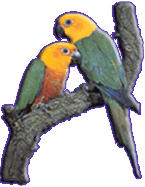|
|
| |
|
|
|
|
MONK PARAKEET
Myiopsitta Monachus |
|
|
Monk parakeet comes from South America , mostly Bolivia , southern Brazil , Central region of Uruguay and Argentina . This species live at height of 1000m above sea level. They make nests in tall bushes and tree branches. It is very interesting that these birds are nesting in colonies, but in such way that more couples use one nest. This is characteristic of monk parakeets, because as we know all other parrot species, even though they nest in colonies, every couple make there own, and mostly in tree trumps and stumps. Monks build their nests using twigs and sticks, very much alike crows and magpies. One pair starts building the nest by making the base. Male is finishing the exterior while the female is in charge for interior. Female is taking in the nest blades of grass and thin barks of a tree, on which she will lay the eggs when the time comes. The other pairs are helping the first couple and start widening the nest by making new ones around it. The result can be amazing, the dimensions of the nest is raising as the number of couples rises. The whole nest construction can be 3m in diameter and weighing over 200kg. The nest is build in such a way that every pair has its own entrance, aside or on the bottom of primary nest. Interior of the nest is also very specific, because every separate nest has its own entrance, anteroom and bedroom, so the nest looks like an apartment house with lots of small apartments. Having all this in mind, the building of this great construction sometimes lasts even 3 months. After the mating, female lays 4 to 6 white eggs in two days interval between each egg. It is hard to say for sure how long does the incubation period lasts because of the complicated nest construction and eggs control, but it is about 22 to 26 days. Youngsters stay in nest for 6 weeks after they come out of the egg, and their first flight is after just one week. The first flight is the time for the first independent meal, and that is one more specific characteristic of these parrots. In one mating season, one couple can rear up to two broods. As for the nest, it is in use for several years. |
| |
|
|
| |
|
The monk parakeet is around 27 to 30 cm, which means this species is medium sized. It has graduated greenish blue tail and bright green back, while the breasts are pale grey and blue with dark blue almost black horizontal stripes. Forehead is gray-brown and nape is green. It has big black eyes and very strong pale gray beak. The male is a bit bigger than female. Youngsters have less bright colors than adults do, their breasts are grey with less expressive stripes. Later, their feathers become bluer and the stripes fully expressed, and that is why Monks are the only ones to belong to the unique Myiopsitta species. Their song is very loud one when they are in the flock, especially if they are in dangerous or if they spot something unusually.
Their daily menu is the same as menu of other medium sized parrots: proso, oat, sunflower, bright seed sorghum, hemp and canary seed, enriched with minerals and vitamins. Off course, fresh fruits and vegetables must not be forgotten.
As a pet, Monk can be very loud, but just in the beginning. When it gets use to the environment, it will be less loud. The Monk can learn around one hundred words, so if you have enough patients the loud song will be history and you will have a friend to talk with. There is one more thing that makes Monk so special. This bird will always let you know if some unknown person is in the house, so if you get a Monk you will get an alarm, too. |
| |
|
|
| |
|
|
| |
|
|
|
| |
|
|
|

